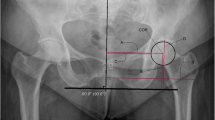Abstract
Background
Studies directly evaluating the reliability of the Risser sign are few in number, possess small sample sizes, and offer conflicting results. This study establishes the reliability of the Risser sign on a large sample size in an effort to provide clarification on the subject.
Methods
Two years’ worth of AP pelvis radiographs from patients age 8–20 were downloaded from our institution’s digital imaging system. One hundred of these images were selected for inclusion by an independent reviewer whose goal was to capture a spread of radiographs that included all Risser stages. Risser grading occurred in two rounds. In each round, three examiners randomly reviewed the 100 radiographs on three different occasions. The full AP pelvis radiograph was graded in Round 1 while only the iliac apophysis was visible in Round 2. Kappa coefficients and their confidence bounds are reported to indicate intra- and inter-observer reliability. The contrast between the rates of agreement about Risser stages in Rounds 1 versus 2 was assessed by McNemar’s test. The signed-rank test was used to evaluate differences in intra-observer values between rounds.
Results
Round 1 inter-observer kappa was 0.76. Round 2 inter-observer kappa was 0.51. In Round 1, 63 radiographs showed perfect agreement within the same Risser stage for all observations compared to 44 radiographs with perfect agreement within the same Risser stage in Round 2 (p = 0.004). Round 1 intra-observer kappa values were 0.92, 0.86, and 0.88. Round 2 intra-observer kappa values were 0.91, 0.77, and 0.88. Intra-observer value differences between rounds were not significant for two observers (p = 0.074, 0.061) but was significant for the third observer (p = 0.002).
Conclusion
The reliability of the Risser sign is acceptable and can be further improved when other markers of skeletal maturity on the pelvis radiograph are used to assist in grading.


Similar content being viewed by others
References
Goldberg MS, Poitras B, Mayo NE, Labelle H, Bourassa R, Cloutier R. Observer variation in assessing spinal curvature and skeletal development in adolescent idiopathic scoliosis. Spine 1998;13: 1371–1377.
Shuren N, Kasser JR, Emans JB, Rand F. Reevaluation of the use of the Risser sign in idiopathic scoliosis. Spine 1992;17: 359–361.
Scoles PV, Salvagno R, Villalba K, Riew D. Relationship of iliac crest maturation to skeletal and chronologic age. J Pediatr Orthop 1988;8: 639–644.
Risser JC. Important practical facts in the treatment of scoliosis. AAOS Instructional Course Lectures. Ann Arbor 1948;5: 248–260.
Efron B, Tibshirani R. An introduction to the bootstrap. London: Chapman & Hall; 1993.
Lee J, Fung KP. Confidence interval of the kappa coefficient by bootstrap resampling [letter]. Psychiatry Res 1993;49: 97–98.
Fleiss JL, Cohen J, Everitt BS. Large sample standard errors for kappa and weighted kappa. Psychol Bull 1996;72: 323–327.
Fleiss JL. Statistical methods for rates and proportions. 2nd ed. NY: Wiley; 1981.
Landis JR, Koch GG. The measurement of observer agreement for categorical data. Biometrics 1977;33: 159–174.
Risser JC, Ferguson AB. Scoliosis: its prognosis. J Bone Joint Surg 1936;18-A: 667–670.
Zaoussis AL, James JIP. The iliac apophysis and the evaluation of curves in scoliosis. J Bone Joint Surg 1958;40: 442–453.
Hoppenfield S, Lonner B, Murthy V, Gu Y. The rib epiphysis and other growth centers as indicators of the end of spinal growth. Spine 2004;29: 47–50.
Dimeglio A. Growth in pediatric orthopaedics. In: Morrissy RT, Weinstein SL, editors. Lovell & Winter’s pediatric orthopaedics. 5th ed. Philadelphia, PA: Lippincott Williams & Wilkins; 2000. p. 42–45.
Acknowledgment
The authors would like to thank Capt. Bruce Gillingham, MD.
Author information
Authors and Affiliations
Corresponding author
Additional information
The Chief, Bureau of Medicine and Surgery, Navy Department, Washington, D.C., Clinical Investigation Program, sponsored this report # 05-039 as required by NSHSBETHINST 6000.41B. The views expressed in this article are those of the authors and do not reflect the official policy or position of the Department of the Navy, Department of Defense, or the United States Government.
Key points:1. The inter-observer agreement of the Risser sign is substantial. 2. The intra-observer agreement of the Risser sign is almost perfect.3. The reliability of the Risser sign can be improved when other markers of skeletal maturity on the pelvis radiograph are used to assist in grading.
Rights and permissions
About this article
Cite this article
Reem, J., Carney, J., Stanley, M. et al. Risser sign inter-rater and intra-rater agreement: is the Risser sign reliable?. Skeletal Radiol 38, 371–375 (2009). https://doi.org/10.1007/s00256-008-0603-8
Received:
Revised:
Accepted:
Published:
Issue Date:
DOI: https://doi.org/10.1007/s00256-008-0603-8




